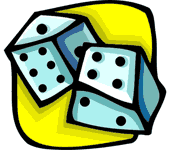STRUGGLE FOR ROME
Ranking: Four stars
Review
Struggle for Rome is just a bit different from all the other Settlers of Catan games—intriguingly so. The main difference is the way your pieces move on the board: there are no roads to place; instead, you move in whatever directions you want, hopping several intersections at once, limited only by arrows drawn on the board. (The arrows don't indicate direction; they're like barriers that you pass. You can pass one for free, but have to pay to pass more than one.) Initially, your two tribes zoom around the board, which is kind of exciting.
There are many paths toward winning, but it doesn't feel like there are too many options to juggle. The main thing you have to decide in Rome is when your tribes should settle down and stop plundering. The second thing is to decide whether to buy supply wagons, men, or development cards. Overall, Rome plays a bit like Stone Age Settlers, where you have to let go of your initial placements in order to expand across the board, but unlike Stone Age, once you settle, you never lose your settlements.
We don't usually like hidden stuff in games, so we were wary about the two kinds of hidden information in Rome. First, after you plunder a city, you turn over a counter to find out what you gain or lose. And second, the pile of pasture resources, which come in two types—cattle and horses—is left facedown, so when you draw a card from the pile you don't know which type you'll get. But the hidden stuff doesn't affect the game as strongly as it does in Seafarers or in Spacefarers or in Stone Age; you don't waste a bunch of resources or time getting someplace only to find it's worthless. Despite the hidden stuff, in Rome you can still optimize intelligently rather than be at the mercy of random chance. So we decided that, on the whole, we like the hidden stuff.
Unlike most of the other Settlers games, play proceeds in rounds made up of phases. Each player takes a turn being the first player in successive rounds. (It's strange that Klaus Teuber didn't include a marker to help players remember who's the first player in a round. We started by using a battery as a marker—a Battery of Power—and now we use a clunky metal Ring of Power to indicate which player is first.) Being the first to play in a round is a definite advantage, which adds another intriguing element to the game.
Finally—and interestingly—the dice probabilities have changed in Rome because in each round's four dice rolls, you can't roll the same number twice, which improves the chances of rolling the usually less-frequent numbers (like 2, 3, 11, and 12). The seven is also defanged; you don’t lose half your cards if you hold more than seven cards in your hand, so you can accumulate resources and wait before you build stuff. And the thief (called the Legionnaire) isn't allowed to be placed east of the Limes—the area in which all players start—which prevents early strangulation.
Unlike other Settlers games, in playing Struggle for Rome we haven't each calcified into using one favorite strategy in game after game. That's a good thing; it keeps us playing.

